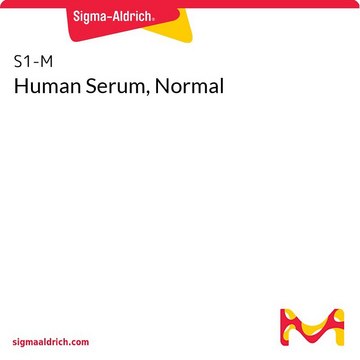291M-1
MUC2 (MRQ-18) Mouse Monoclonal Antibody
About This Item
Produtos recomendados
fonte biológica
mouse
Nível de qualidade
100
500
conjugado
unconjugated
forma do anticorpo
culture supernatant
tipo de produto de anticorpo
primary antibodies
clone
MRQ-18, monoclonal
descrição
For In Vitro Diagnostic Use in Select Regions (See Chart)
forma
buffered aqueous solution
reatividade de espécies
human
embalagem
vial of 0.1 mL concentrate (291M-14)
vial of 0.5 mL concentrate (291M-15)
bottle of 1.0 mL predilute (291M-17)
vial of 1.0 mL concentrate (291M-16)
bottle of 7.0 mL predilute (291M-18)
fabricante/nome comercial
Cell Marque™
técnica(s)
immunohistochemistry (formalin-fixed, paraffin-embedded sections): 1:50-1:200
Isotipo
IgG1κ
controle
colon
Condições de expedição
wet ice
temperatura de armazenamento
2-8°C
visualização
cytoplasmic
Informações sobre genes
human ... MUC2(4583)
Categorias relacionadas
Descrição geral
The heterogeneous pattern of mucin expression, including the expression of the intestinal mucin MUC2, may provide new insights into the differentiation pathways of gastric carcinoma. The pattern of mucin expression may also be used as a clue to bring new insights into the biological behaviour of distinct clinicopathological entities related to the localisation of gastric carcinoma, namely proximal and distal gastric carcinomas. Pinto-de-Sousa et al. have shown in a comprehensive study of gastric carcinomas evaluated for expression of several mucins (MUC1, MUC2, MUC5AC and MUC6) that: (1) mucin expression is associated with tumour type (MUC5AC with diffuse and infiltrative carcinomas and MUC2 with mucinous carcinomas) but not with the clinico-biological behaviour of the tumours; and (2) mucin expression is associated with tumour location (MUC5AC with antrum carcinomas and MUC2 with cardia carcinomas), indirectly reflecting differences in tumour differentiation according to tumour location.
The following generalities apply to the patterns of Mucin expression:
MUC1 expression: apical surfaces of most epithelial cells in breast, GI, respiratory, and GU tracts.
MUC2 expression: specifically expressed in goblet cells of the small intestine & colon.
Colonic CAs – 65%, Gastric CAs – 42%, Esophageal CAs – 17%
Rare outside of GI tract – with exception of; mucinous ca of breast, clear cell-type CAs of the ovary.
Qualidade
 IVD |  IVD |  IVD |  RUO |
Ligação
forma física
Nota de preparo
Outras notas
Informações legais
Não está encontrando o produto certo?
Experimente o nosso Ferramenta de seleção de produtos.
Certificados de análise (COA)
Busque Certificados de análise (COA) digitando o Número do Lote do produto. Os números de lote e remessa podem ser encontrados no rótulo de um produto após a palavra “Lot” ou “Batch”.
Já possui este produto?
Encontre a documentação dos produtos que você adquiriu recentemente na biblioteca de documentos.
Nossa equipe de cientistas tem experiência em todas as áreas de pesquisa, incluindo Life Sciences, ciência de materiais, síntese química, cromatografia, química analítica e muitas outras.
Entre em contato com a assistência técnica

